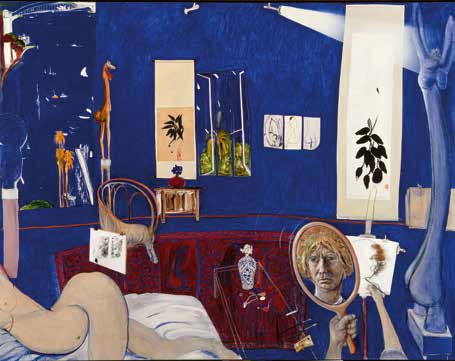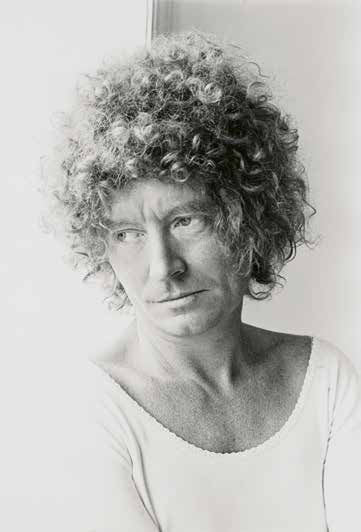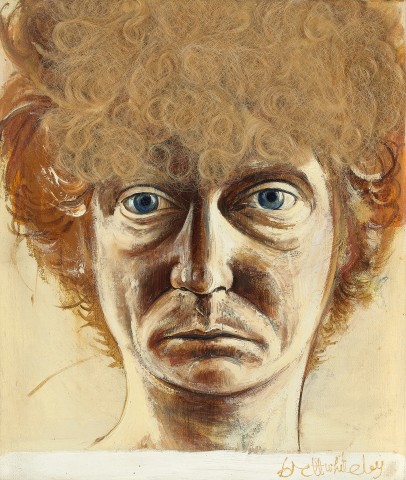SELF PORTRAIT, 1977
BRETT WHITELEY
oil and hair on canvas
30.5 x 25.5 cm
signed lower right: brett whiteley
Joseph Brown Gallery, Melbourne, 1977
Joan Clemenger AO and Peter Clemenger AO, Melbourne, acquired from the above in April 1979
Autumn Exhibition, Joseph Brown Gallery, Melbourne, 5 – 20 April 1979, cat. 157 (illus. in exhibition catalogue, as ‘Self Portrait’)
Sutherland, K., Brett Whiteley: Catalogue Raisonné, Schwartz Publishing, Melbourne, 2020, cat. 117.77, vol. 3, p. 445 (illus.), vol. 7, p. 407
Self – Portrait in the Studio, 1976, oil, collage, hair on canvas, 200.5 x 259.0 cm, in the collection of the Art Gallery of New South Wales, Sydney, winner of the 1976 Archibald Prize
Self – Portrait after a Haircut at 36, 1976, pen and ink and hair on paper, 100.0 x 75.0 cm, private collection, Melbourne, sold Deutscher and Hackett, Melbourne, 15 July 2020, lot 23
Self Portrait with Real Hair, 1977, ink and hair on paper, 76.0 x 51.0 cm, whereabouts unknown
1 whit.jpg

Brett Whiteley was never shy when it came to measuring himself against the masters. At the age of 16, while boarding at Scots College in Bathurst, he came across a book on Vincent Van Gogh and painted a self-portrait in emulation of the famously misunderstood Dutchman. At 16 we are all misunderstood and ready to identify with Van Gogh, but few teenagers could have created such an accomplished homage. The young Whiteley duplicates the three-quarter turn of the head, the painter’s sullen – or soulful – gaze which holds the viewer’s eye.
Throughout his career, Whiteley would return again and again to the self-portrait, as a form of self-examination and self-dramatisation. The present Self-portrait, 1977 sits squarely between his two Archibald Prize winners: Self-portrait in the studio, 1976, and Art, life and the other thing, 1978 (both in the collection of the Art Gallery of New South Wales).
In the former, Whiteley’s face appears in a hand-held mirror, as one small feature on a large, luxuriant ground of deep blue. The work is an anthology of Whiteley motifs, including the view of Sydney Harbour from a window, a reclining nude, an armchair, and a piece of blue-and-white china. The room is a veritable salon hang of the artist’s sculptures and drawings. The dominant impression is one of ‘luxe, calme et volupté’, in the manner of Henri Matisse, whose painting, The Red Studio, 1911, was Whiteley’s chief source of inspiration.
The second painting has a completely different tone. An unconventional triptych, it consists of a small, coloured photo of Whiteley’s face; a distorted full-length portrait of him drawing a copy of Dobell’s Joshua Smith, the controversial Archibald winner of 1943; and a panel that features a screaming baboon in handcuffs, staring helplessly at a hand offering a hypodermic. It was a daring, overt reference to a drug habit that many of Whiteley’s admirers expected to cut short his career.
In little more than two years Whiteley had moved from a languorous vision of the studio to a sensational, confessional self-portrait set against a pale, terracotta ground. The absorbing detail of the first painting has disappeared, as the artist withdraws into his own head. Whiteley’s biographer, Ashleigh Wilson, describes the work as ‘a confronting depiction of the panic and desperation of drug addiction. Brett said he had wanted it to scare him straight.’1
It was, at the very least, a way of exposing his own dark obsessions to the widest possible audience and the full glare of publicity. As it turned out, he could be neither scared nor shamed into giving up heroin.
The Self-portrait, 1977 on offer represents a far less theatrical attempt at self-reflection. Whiteley looks out at us directly, with none of the emotional address of his early ‘Van Gogh’ style portrait, none of the mock decadence of 1976, or the drug-fuelled angst of 1978. His expression is completely blank, as if he wanted only to pause and take stock of himself. A handful of his own curly, reddish hair glued to the picture signifies a desire to explore a higher kind of realism, as if mere paint on canvas were insufficient to the task.
It might be argued that the hair is an affectation Whiteley used too frequently for comfort. It features in all three self-portraits from 1976 – 78, acting as a signature or trademark. No other Australian artist had such a wild, woolly set of curls. No other artist left traces of his own locks on so many canvases. One suspects a touch of trichophilia – a fetishising of hair with vague sexual overtones. A bald psychiatrist, Dr. Charles Berg, wrote an entire book in the subject, The Unconscious Significance of Hair (1951).2
1 white.jpg

In explaining his use of collage, which often saw him adding photographs or objects to a canvas, Whiteley said he did it ‘when I feel the need to describe in the focus of the painting something that requires infinite realism, a realism so absolute that no amount of painstaking brush strokes can accurately describe it.’3
One could be cynical about these additions, seeing them as pictorial short cuts that saved a lot of time and effort, but it’s entirely plausible Whiteley was motivated solely by inner necessity – or at least, his own, idiosyncratic version of the concept. Kandinsky had a complex, theoretical understanding of the term, involving the artist’s personality, the context of their times, and the harmonious nature of a composition.4 For Whiteley it was more like a compulsion to break the imaginary rules of painting, to be spontaneous and transgressive – and to be recognised for these revolutionary gestures. The urge was bound up with a self-conscious sense of his own genius.
Wilson quotes a letter the artist addressed to his mother, in January 1979, in which he writes of ‘the realization of the deep responsibility I have to my talent, to share it with my fellow Australians… with the world… I am fighting the biggest struggle of my life at the moment. I am trying to become a great man.’5
In retrospect, Whiteley’s life and work during the 1970s when he was widely perceived as Australia’s leading artist, may be seen as a time of great personal conflict. He was aware of the harm he was doing to himself with his drug addiction, but worried that giving it up might impair his creativity. He believed he had a gift he needed to share with everyone but couldn’t escape his habitual self-centredness. Having attained the height of success, he realised that from this pinnacle the only way is down.
In the midst of such inner turmoil, Self-portrait, 1977, is a remarkably straight work – a still point in a stormy decade. It shows Whiteley looking at himself intently in the mirror and recording exactly what he sees. We’re not looking at a would-be genius or a sinful penitent. It’s not the dark, edgy image of a celebrity, but the portrait of an artist.
1. Wilson, A., Brett Whiteley: Art, Life and the Other Thing, Text Publishing, Melbourne, 2016, p. 272
2. Berg, C., The Unconscious Significance of Hair, George Allen & Unwin, London, 1951
3. Brett Whiteley quoted in McGrath, S., Brett Whiteley, Bay Books, Sydney, 1979, p. 219
4. Kandinsky, Wassily, On the Spiritual in Art, 1910
5. Wilson, op. cit., p. 277
JOHN MCDONALD
John McDonald is art critic for the Sydney Morning Herald and film critic for the Australian Financial Review.
www.johnmcdonald.net.au
